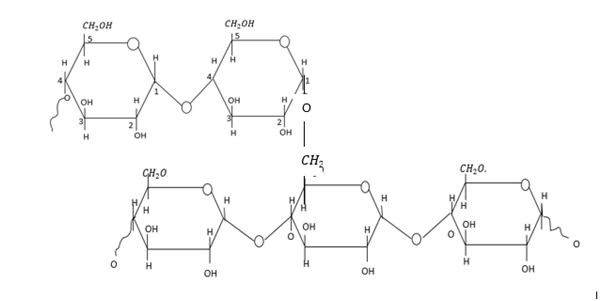
Amylopectin is a polymer of
(A)
(B)
(C) Lactose
(D) Amylose
Answer
156k+ views
Hint: Polymer is a substance consisting of a large number of molecules or macromolecules and composed of many repeating units.
Example. silk, wool, DNA, cellulose, proteins are all natural polymers.
Complete step by step answer:
Amylopectin is polysaccharide and a highly branched polymer. They are found in plants.
Amylopectin is one of the two important components of starch. It is water soluble.
The repeating unit in Amylopectin is
A glycosidic linkage is a covalent bond that allows the linking of two monosaccharides together.
Amylopectin contributes about 80% of starch

Linkage between two monosaccharide molecules through oxygen is called glycosidic linkage.
Therefore, by the above explanation, the correct option is [A]
Note: Polysaccharides have a large number of same or different monosaccharides, linked together by glycosidic linkage. They have molecular formula
Another part of starch is Amylose. This is a water soluble part of starch.
Example. silk, wool, DNA, cellulose, proteins are all natural polymers.
Complete step by step answer:
Amylopectin is polysaccharide and a highly branched polymer. They are found in plants.
Amylopectin is one of the two important components of starch. It is water soluble.
The repeating unit in Amylopectin is
A glycosidic linkage is a covalent bond that allows the linking of two monosaccharides together.
Amylopectin contributes about 80% of starch

Linkage between two monosaccharide molecules through oxygen is called glycosidic linkage.
Therefore, by the above explanation, the correct option is [A]
Note: Polysaccharides have a large number of same or different monosaccharides, linked together by glycosidic linkage. They have molecular formula
Another part of starch is Amylose. This is a water soluble part of starch.
Latest Vedantu courses for you
Grade 11 Science PCM | CBSE | SCHOOL | English
CBSE (2025-26)
School Full course for CBSE students
₹41,848 per year
EMI starts from ₹3,487.34 per month
Recently Updated Pages
JEE Atomic Structure and Chemical Bonding important Concepts and Tips

JEE Amino Acids and Peptides Important Concepts and Tips for Exam Preparation

Difference Between Alcohol and Phenol

Classification of Drugs Based on Pharmacological Effect, Drug Action

JEE Main Mock Test Series Class 12 Chemistry for FREE

JEE Electricity and Magnetism Important Concepts and Tips for Exam Preparation

Trending doubts
JEE Main 2025 Session 2: Application Form (Out), Exam Dates (Released), Eligibility, & More

JEE Main 2025: Derivation of Equation of Trajectory in Physics

Electric Field Due to Uniformly Charged Ring for JEE Main 2025 - Formula and Derivation

Degree of Dissociation and Its Formula With Solved Example for JEE

Displacement-Time Graph and Velocity-Time Graph for JEE

Geostationary Satellites and Geosynchronous Satellites - JEE Important Topic

Other Pages
JEE Advanced Marks vs Ranks 2025: Understanding Category-wise Qualifying Marks and Previous Year Cut-offs

NCERT Solutions for Class 12 Chemistry Chapter 1 Solutions

NCERT Solutions for Class 12 Chemistry Chapter 2 Electrochemistry

NCERT Solutions for Class 12 Chemistry Chapter 6 Haloalkanes and Haloarenes

Solutions Class 12 Notes: CBSE Chemistry Chapter 1

NCERT Solutions for Class 12 Chemistry Chapter 7 Alcohol Phenol and Ether




